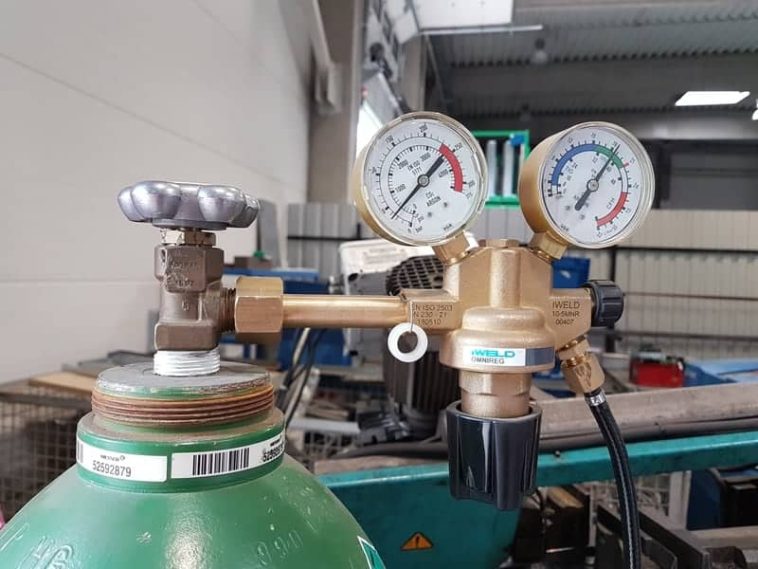
MIG Welding Gas Pressure: The Complete Guide to Flow, Settings, and Troubleshooting
Why Shielding Gas Flow Matters
Consistent MIG welding gas pressure and accurate shielding gas settings protect the molten pool from atmospheric contamination. Too little flow encourages porosity in welds; too much can cause turbulence, cold lap, and wasted gas. For a concise primer on the ideal gas pressure for MIG and how flow ties to weld quality, see nexAir’s overview: What is the Ideal Gas Pressure for MIG Welding?
Recommended Flow Ranges and Mixes
General indoor ranges (short-circuit and spray)
A practical MIG gas flow rate for most indoor work is 20–25 cubic feet per hour (CFH), with small adjustments for joint design and draft control. For a quick range reference, review standard MIG gas flow rates.
Mild steel gas settings
For mild steel gas settings, many shops start with an argon CO2 mixture (commonly 75/25) around 15–20 CFH, then fine‑tune based on bead appearance and spatter. This aligns with YesWelder’s guidance on setting MIG gas pressure for mild steel.
When to increase or reduce flow
If you see porosity in welds or are welding near an open door, raise flow toward 25–30 CFH; if the arc becomes erratic or the bead is crowned and cold, reduce flow. For situational adjustments and a gas pressure chart reference, see MIG welding gas pressure settings with charts.
Units, Instruments, and Conversions
Pressure vs flow rate
In MIG, we control shielding gas by flow—not pressure. Many newcomers confuse PSI with CFH. If your MIG welding regulator shows PSI only, you’re reading cylinder pressure, not shielding flow. A helpful community reminder that gas is set in cubic feet per hour, not PSI, is in this beginner r/Welding thread.
CFH to LPM conversion
If you prefer liters per minute (LPM), convert quickly:
- LPM = CFH × 0.472
- CFH = LPM × 2.12
Example: 20 CFH ≈ 9.4 LPM. For LPM-centered shop norms and a practical gas pressure chart, see this MIG Welding Forum discussion.
Setup and Flow Gauge Adjustment
Step-by-step setup
- Secure the cylinder and connect the MIG welding regulator.
- Crack open the valve, purge the line, and power the machine.
- Squeeze the trigger to flow gas, then perform a flow gauge adjustment to the target CFH (start at 20 CFH indoors).
- Strike a short bead and fine‑tune flow for bead wetting and minimal spatter.
Argon flow rate checkpoints
As you dial in argon flow rate, consider joint fit-up, stickout, and position. While recommendations vary by process and mode, this Q&A offers common ranges and practical caveats: What pressure should argon have for MIG welding?
Nozzle Size, Laminar Flow, and Wind Control
Gas nozzle size and diffuser effects
Larger nozzles and cups require slightly higher flow to maintain a protective envelope. Increase a few CFH as gas nozzle size grows, ensure your diffuser promotes laminar gas flow, and keep the nozzle clean. Practical starting points by nozzle ID are discussed in this Miller forum thread on recommended gas pressure.
Outdoor welding wind strategies
Outdoor welding wind disrupts shielding. Use wind screens, shorten stickout, and raise flow incrementally to the minimum effective level. Avoid excessive flow that causes turbulence and draws in air.
Material-Specific Notes
Mild steel (short-circuit and spray)
- Gas: argon CO2 mixture (e.g., 75/25)
- Typical flow: 18–25 CFH indoors; up to ~30 CFH with drafts
- CO2 mix percentage affects arc force and penetration; higher CO2 increases spatter but boosts penetration and wetting
Stainless steel MIG
- Gas: low CO2 mix percentage (e.g., 98/2 Ar/CO2) or approved tri‑mixes for short‑circuit; follow your WPS
- Typical flow: 20–25 CFH with careful tuning for bead color and oxidation control
Troubleshooting: Porosity, Spatter, and Inconsistent Beads
Eliminate porosity in welds
- Check for leaks, kinked hoses, clogged diffusers, and damaged O‑rings
- Reduce drafts and ensure laminar gas flow
- Verify adequate flow: 20–25 CFH indoors; increase for larger nozzles or mild drafts
- Clean base metal and wire; moisture and oil create gas pockets
Stabilize the arc and bead
- Match the CO2 mix percentage and wire diameter to process mode and material thickness
- Maintain consistent stickout (3/8–1/2 in for short‑circuit)
- If bead is raised with poor fusion, slightly lower flow or increase heat input
FAQs
What is the ideal gas pressure for MIG?
We set flow, not pressure. For indoor work, an ideal gas pressure for MIG translates to about 20–25 CFH (roughly 9–12 LPM), adjusted for gas nozzle size, position, and any draft.
Should I adjust flow differently for stainless steel MIG?
Yes. Stainless is sensitive to oxidation; use mixes with low CO2 mix percentage or approved tri‑mixes and hold flow near 20–25 CFH. Increase only as needed to avoid turbulence.
How do I know if my flow is correct without a flowmeter?
Watch the bead: glossy puddle, minimal spatter, and no pinholes after cooling. If your regulator only shows PSI, add a flowmeter or reference a calibrated gas pressure chart and verify with CFH to LPM conversion.
Meta description: Set MIG welding gas pressure the right way. Learn recommended MIG gas flow rate in cubic feet per hour and liters per minute, best argon CO2 mixture, shielding gas settings by material, gas nozzle size and laminar gas flow, pressure vs flow rate, CFH to LPM conversion, and how to prevent porosity in welds for stainless steel MIG and mild steel gas settings.

